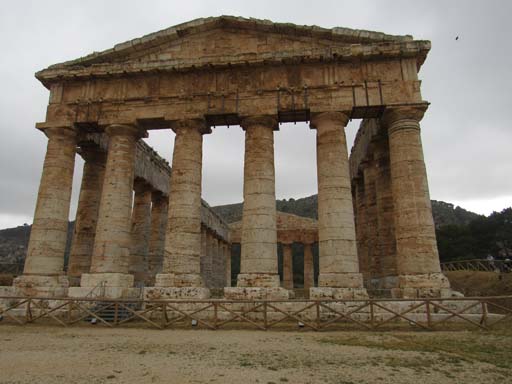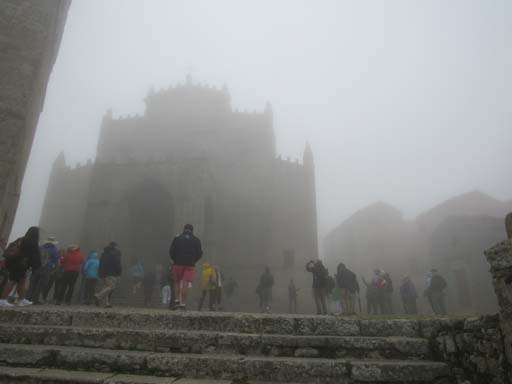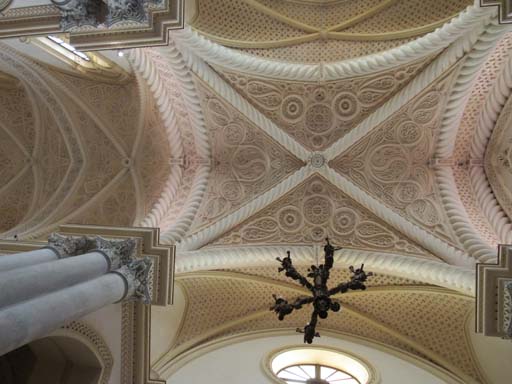By Sunday everything had improved except the weather. Kathy reported that she was swiftly recovering from the worst effects of COVID, and my knee had improved to the point where I could walk nearly pain-free. (I think what might have happened was that my accident had knocked free a piece of cartilage, which was moving around inside the knee joint and causing pain or not according to where it ended up that day.)
At any rate I felt after a hearty breakfast ready to set forth and encounter an ancient ethnic group that I’d never even heard of: the Elymians. By the classical period, the Elymians had carved themselves a wedge of northwestern Sicily for their homeland. With the aggressive Carthaginians to the south, and the equally-aggressive Greeks to the east, the Elymians were encamped in a dangerous place, but they held onto their home turf and maintained their identity for centuries until they were absorbed into the Roman empire, which shows they were pretty damn resourceful.
It helped that their homeland was mountainous, with natural forts on every peak, and difficult for strangers to attack. I saw one incredible vista after another, all of which would have been gorgeous if the view hadn’t been spoiled by low-hanging cloud, rain, drizzle, sleet, and whatever else the sky was throwing at us that hour.
According to some, the Elymians were descended from refugee Trojans, which no doubt helped when it came to dealing with the Romans, who considered themselves descended from Trojan Aeneas. (Aeneas was a Dardanian prince, not a Trojan, and he founded Alba Longa, not Rome, but after a millennium or so it’s probably all the same.)
On arrival at the Elymian city of Segesta, the most impressive thing in view was seven gorgeous Ferrari automobiles parked in a row, along with a no-less-impressive Maserati. After a time their owners appeared, donned their motoring caps, and drove off together in one colorful, impressive, and very noisy convoy. All in all, viewing impressive scenery from the cabin of a Ferrari seems a very elevated way to spend one’s Sunday.
Segesta was, not surprisingly, on top of an easily-defended ridge, but I was able to manage the goat track without too much grief, keeping the rain off with my North Face hooded rain jacket. The Elymians, faced with a choice of cultures to adopt, had chosen Greek, and their city was arranged around a very large agora that had been carved out of the mountain in three terraces. The agora, and everything else, consists of nothing now but ruins. Some distance behind the agora was the Greek theater, which opened out onto a spectacular view of the mountain that holds the village of Erice— it would have been gorgeous had it not been for the low-hanging cloud capping the mountain and spitting out cold drizzle. Any theater productions would have had that view for a backdrop, which would have been a terrific distraction for any audience. The actors must have hated playing there.
So we trudged down into the valley, and then trudged up again to the Doric Temple of Athena. During the Peloponnesian War the Elymians allied with the Athenians against the local bullies in Syracuse, and felt that they’d score points with their allies by building a temple to their titular deity. But the Athenian Expeditionary Force lost the campaign in spectacular fashion, with the entire army and fleet captured, and so the Elymians cut their losses and never finished the temple. It never had a roof, or an altar, or a cult statue. (The Elymians did a swift turnabout and allied with Carthage, which sent mercenaries to successfully defend Segesta against its enemies.)
Kudos to the temple architects, because their work has survived amazingly well. There must have been hundreds of earthquakes in the last 2500 years, and the temple endured them all without taking damage. It has been harmed only once, in a recent lightning strike— and if you expand the picture and look on the upper left corner, you may see an iron staple driven in to reinforce a block of stone cracked by the lightning.
So then back to our vehicle, and down into a valley and up a mountain to the village of Erice. (The ancient name was Eryx.) This involved negotiating a narrow switchback road up a very steep mountainside, which would have offered more spectacular views if we hadn’t driven up into a cloud, which at times reduced visibility close to zero. Of course we encountered vehicles coming the other way, usually on a blind corner, but there seems to have been a protocol of some sort that gives right-of-way to those driving up, not down, the mountain, and none of us died.
Eryx had mixed Punic and Elymian origins, and during ancient times was famous for a shrine to a goddess called by the Romans “Venus Ericina.” The Normans later built a castle atop the goddess’ shrine, then put a cathedral further down the slope, near the city gate.
I stepped through the gate into a blinding sleet storm, driven by a cold wind that tore right through my North Face jacket and left me shivering. I decided not to make a stop in the inviting gelateria. I decided also not to make the trek to the Norman castle and took shelter in the cathedral, which is right next to a monumental watch tower, now converted to a bell tower. The cathedral is small as cathedrals go, and features neat, precise geometrical carving on, well, everything. They charge a couple euros to go in.
After enjoying the cathedral, I allowed the wind to blast me back through the gate and boarded our chariot for the perilous ride down the mountain. Which I survived quite well, as you may discern from the fact that I write this from my easy chair, and not from my heavenly throne.



Eryx wins for most possible points for a 4 letter word in Scrabble, especially if you can play it over a triple-point square.
But Eryx is a proper name. Doesn’t that disallow it?
Comments on this entry are closed.